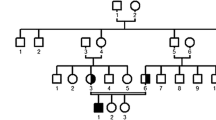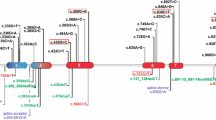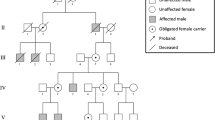Abstract
Summary
This is the first Egyptian study with detailed clinical and orodental evaluation of eight patients with pycnodysostosis and identification of four mutations in CTSK gene with two novel ones and a founder effect.
Introduction
Pycnodysostosis is a rare autosomal recessive skeletal dysplasia due to mutations in the CTSK gene encoding for cathepsin K, a lysosomal cysteine protease.
Methods
We report on the clinical, orodental, radiological, and molecular findings of eight patients, from seven unrelated Egyptian families with pycnodysostosis.
Results
All patients were offspring of consanguineous parents and presented with the typical clinical picture of the disorder including short stature, delayed closure of fontanels, hypoplastic premaxilla, obtuse mandibular angle, and drum stick terminal phalanges with dysplastic nails. Their radiological findings showed increased bone density, acro-osteolysis, and open cranial sutures. Mutational analysis of CTSK gene revealed four distinct homozygous missense mutations including two novel ones, c.164A>C (p. K55T) and c.433G>A (p.V145M). The c.164A>C (p. K55T) mutation was recurrent in three unrelated patients who also shared similar haplotype, suggesting a founder effect.
Conclusion
Our findings expand the mutational spectrum of CTSK gene and emphasize the importance of full clinical examination of all body systems including thorough orodental evaluation in patients with pycnodysostosis.





Similar content being viewed by others
References
Arman A, Bereket A, Coker A, Kiper PÖ, Güran T, Ozkan B, Atay Z, Akçay T, Haliloglu B, Boduroglu K, Alanay Y, Turan S (2014) Cathepsin K analysis in a pycnodysostosis cohort: demographic, genotypic and phenotypic features. Orphanet J Rare Dis 9:60. https://doi.org/10.1186/1750-1172-9-60
Morateaux P, Lamy M (1962) Pyknodysostosis. Presse Med 70:999–1002
Muto T, Michiya H, Taira H, Murase H, Kanazawa M (1991) Pycnodysostosis. Report of a case and review of the Japanese literature, with emphasis on oral and maxillofacial findings. Oral Surg Oral Med Oral Pathol 72:449–455
Alves N, Cantín M (2014) Clinical and radiographic maxillofacial features of pycnodysostosis. Int J Clin Exp Med 7(3):492–496
Xue Y, Cai T, Shi S, Wang W, Zhang Y, Mao T, Duan X (2011) Clinical and animal research findings in pycnodysostosis and gene mutations of cathepsin K from 1996 to 2011. Orphanet J Rare Dis 6(1):20. https://doi.org/10.1186/1750-1172-6-20
Araujo TF, Ribeiro EM, Arruda AP, Moreno CA, Medeiros PF, Minillo RM, Melo DG, Kim CA, Doriqui MJ, Felix TM, Fock RA (2016) Molecular analysis of the CTSK gene in a cohort of 33 Brazilian families with pycnodysostosis from a cluster in a Brazilian Northeast region. Eur J Med Res 21(1):33
Turan S (2014) Current research on pycnodysostosis. Intractable Rare Dis Res 3:91–93
Toral-López J, Gonzalez-Huerta LM, Sosa B, Orozco S, González HP, Cuevas-Covarrubias SA (2011) Familial pycnodysostosis: identification of a novel mutation in the CTSK gene (cathepsin K). J Investig Med 59(2):277–280. https://doi.org/10.231/JIM.0b013e318202a9db
Utokpat P, Panmontha W, Tongkobpetch S, Suphapeetiporn K, Shotelersuk V (2013) Novel CTSK mutation resulting in an entire exon 2 skipping in a Thai girl with pycnodysostosis. Pediatr Int 55(5):651–655. https://doi.org/10.1111/ped.12091
Huang X, Qi X, Li M, Wang O, Jiang Y, Xing X, Hu Y, Xia W (2015) A mutation in CTSKgene in an autosomal recessive pycnodysostosis family of Chinese origin. Calcif Tissue Int 96:373–378. https://doi.org/10.1007/s00223-015-9963-y
Song HK, Sohn YB, Choi YJ, Chung YS, Jang JH (2017) A case report of pycnodysostosis with atypical femur fracture diagnosed by next-generation sequencing of candidate genes. Medicine (Baltimore) 96(12):e6367. https://doi.org/10.1097/MD.0000000000006367
Donnarumma M, Regis S, Tappino B, Rosano C, Assereto S, Corsolini F, Di Rocco M, Filocamo M (2007) Molecular analysis and characterization of nine novel CTSK mutations in twelve patients affected by pycnodysostosis. Hum Mutat 28:524–533. https://doi.org/10.1002/humu.9490
Gelb B, Shi G, Chapman H, Desnick R (1996) Pycnodysostosis, a lysosomal disease caused by cathepsin K deficiency. Science 273:1236–1238
Osimani S, Husson I, Passemard S, Elmaleh M, Perrin L, Quelin C, Marey I, Delalande O, Filocamo M, Verloes A (2010) Craniosynostosis: a rare complication of pycnodysostosis. Eur J Med Genet 53:89–92. https://doi.org/10.1016/j.ejmg.2009.12.001
Bertola D, Amaral C, Kim C, Albano L, Aguena M, Passos-Bueno MR (2010) Craniosynostosis in pycnodysostosis: broadening the spectrum of the cranial flat bone abnormalities. Am J Med Genet A 152A:2599–2603. https://doi.org/10.1002/ajmg.a.33609
Rothenbühler A, Piquard C, Gueorguieva I, Lahlou N, Linglart A, Bougnères P (2010) Near normalization of adult height and body proportions by growth hormone in pycnodysostosis. J Clin Endocrinol Metab 95:2827–2831. https://doi.org/10.1210/jc.2009-2531
Li CY, Jepsen KJ, Majeska RJ, Zhang J, Ni R, Gelb BD, Schaffler MB (2006) Mice lacking cathepsin K maintain bone remodeling but develop bone fragility despite high bone mass. J Bone Miner Res 21(6):865–875. https://doi.org/10.1359/jbmr.060313
Yates CJ, Bartlett MJ, Ebeling PR (2011) An atypical subtrochanteric femoral fracture from pycnodysostosis: a lesson from nature. J Bone Miner Res 26(6):1377–1379. https://doi.org/10.1002/jbmr.308
Hashem J, Krochak R, Culbertson MD, Mileto C, Goodman H (2015) Atypical femur fractures in a patient with pycnodysostosis: a case report. Osteoporos Int 26(8):2209–2212. https://doi.org/10.1007/s00198-015-3191-1
Chen W, Yang S, Abe Y, Li M, Wang Y, Shao J, Li E, Li YP (2007) Novel pycnodysostosis mouse model uncovers cathepsin K function as a potential regulator of osteoclast apoptosis and senescence. Hum Mol Genet 16:410–423. https://doi.org/10.1093/hmg/ddl474
Gowen M, Lazner F, Dodds R, Kapadia R, Feild J, Tavaria M, Bertoncello I, Drake F, Zavarselk S, Tellis I, Hertzog P (1999) Cathepsin K knockout mice develop osteopetrosis due to a deficit in matrix degradation but not demineralization. J Bone Miner Res 14:1654–1663. https://doi.org/10.1359/jbmr.1999.14.10.1654
Kiviranta R, Morko J, Alatalo SL, NicAmhlaoibh R, Risteli J, Laitala-Leinonen T, Vuorio E (2005) Impaired bone resorption in cathepsin K-deficient mice is partially compensated for by enhanced osteoclastogenesis and increased expression of other proteases via an increased RANKL/OPG ratio. Bone 36:159–172. https://doi.org/10.1016/j.bone.2004.09.020
Capan E, Turan S, Kilicoglu H (2015) Clinical and cephalometric analysis of three cases with pycnodysostosis: case reports. J Istanbul Univ Fac Dent 49:51–55. https://doi.org/10.17096/jiufd.70673
Wen X, Yi LZ, Liu F, Wei JH, Xue Y (2016) The role of cathepsin K in oral and maxillofacial disorders. Oral Dis 22(2):109–115. https://doi.org/10.1111/odi.12378.
Zhou J, Zhao Y, Xia C, Jiang L (2012) Periodontitis with hypercementosis: report of a case and discussion of possible aetiologic factors. Aust Dent J 57:511–514. https://doi.org/10.1111/j.1834-7819.2012.01725.x
Xue Y, Wang L, Xia D, Li Q, Gao S, Dong M, Cai T, Shi S, He L, Hu K, Mao T, Duan X (2015) Dental abnormalities caused by novel compound heterozygous CTSK mutations. J Dent Res 94:674–681. https://doi.org/10.1177/0022034515573964
Valdes-Flores M, Hidalgo-Bravo A, Casas-Avila L, Chima-Galan C, Hazan-Lasri EJ, Pineda-Gomez E, Lopez-Estrada D, Zenteno JC (2014) Molecular and clinical analysis in a series of patients with pyknodysostosis reveals some uncommon phenotypic findings. Int J Clin Exp Med 7:3915–3923
Alves Pereira D, Berini Aytes L, Gay Escoda C (2008) Pycnodysostosis. A report of 3 clinical cases. Med Oral Patol Oral Cir Bucal 13:E633–E635
Mujawar Q, Naganoor R, Patil H, Thobbi AN, Ukkali S, Malagi N (2009) Pycnodysostosis with unusual findings: a case report. Cases J 2:6544–6547. https://doi.org/10.4076/1757-1626-2-6544
Tolar J, Teitelbaum SL, Orchard PJ (2004) Osteopetrosis. N Engl J Med 351:2839–2849. https://doi.org/10.1056/NEJMra040952
Ketterer S, Gomez-Auli A, Hillebrand LE, Petrera A, Ketscher A, Reinheckel T (2016) Inherited diseases caused by mutations in cathepsin protease genes. FEBS J 284:1437–1454. https://doi.org/10.1111/febs.13980
Berenguer A, Freitas AP, Ferreira G, Nunes JL (2012) A child with bone fractures and dysmorphic features: remember of pycnodysostosis and craniosynostosis. BMJ Case Rep 2012:bcr2012006930. https://doi.org/10.1136/bcr-2012-006930
Caracas HP, Figueiredo PS, Mestrinho HD, Acevedo AC, Leite AF (2012) Pycnodysostosis with craniosynostosis: case report of the craniofacial and oral features. Clin Dysmorphol 21:19–21. https://doi.org/10.1097/MCD.0b013e32834c7da7
Acknowledgements
We thank all patients and their families for participation in the study. This work was supported by STDF project no. 5253.
Author information
Authors and Affiliations
Corresponding author
Ethics declarations
Conflicts of interest
None.
Rights and permissions
About this article
Cite this article
Otaify, G.A., Abdel-Hamid, M.S., Mehrez, M.I. et al. Genetic study of eight Egyptian patients with pycnodysostosis: identification of novel CTSK mutations and founder effect. Osteoporos Int 29, 1833–1841 (2018). https://doi.org/10.1007/s00198-018-4555-0
Received:
Accepted:
Published:
Issue Date:
DOI: https://doi.org/10.1007/s00198-018-4555-0




